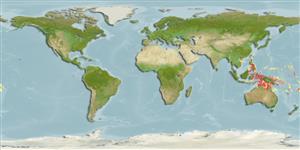Actinopterygii (ray-finned fishes) >
Siluriformes (Catfish) >
Ariidae (Sea catfishes) > Ariinae
Environment / Climate / Range
Ecology
Marine; brackish; benthopelagic. Tropical, preferred ?
Western Pacific: northern Australia and southern New Guinea.
Size / Weight / Age
Maturity: Lm ? range ? - ? cm
Max length : 39.5 cm SL male/unsexed; (Ref. 30691)
Dorsal
spines
(total): 1;
Anal
soft rays: 22 - 25. Body coppery, golden brown, bronze or greyish pink. Dorsomedian head groove deep and elliptical posteriorly. Long barbels with maxillary pair 30 - 56% of SL; bases of chin barbels well separated and staggered. Gill rakers largely absent from hind aspect of the first 2 gill arches. Dorsal fin spine with a short filament at all ages (Ref. 38478).
Inhabits coastal waters and estuaries, river deltas and rivers within tidal influence. Feeds mainly on prawns and other crustaceans, fish, aquatic insects, plant material, and fish scales taken opportunistically (Ref. 38478).
Life cycle and mating behavior
Maturity | Reproduction | Spawning | Eggs | Fecundity | Larvae
Kailola, P.J., 1999. Ariidae (=Tachysuridae): sea catfishes (fork-tailed catfishes). p. 1827-1879. In K.E. Carpenter and V.H. Niem (eds.) FAO species identification guide for fishery purposes. The living marine resources of the Western Central Pacific. Vol. 3. Batoid fishes, chimaeras and bony fishes part 1 (Elopidae to Linophrynidae). FAO, Rome. (Ref. 38478)
IUCN Red List Status (Ref. 115185)
CITES (Ref. 94142)
Not Evaluated
Threat to humans
Traumatogenic (Ref. 58010)
Human uses
More information
Common namesSynonymsMetabolismPredatorsEcotoxicologyReproductionMaturitySpawningFecundityEggsEgg development
ReferencesAquacultureAquaculture profileStrainsGeneticsAllele frequenciesHeritabilityDiseasesProcessingMass conversion
Tools
Special reports
Download XML
Internet sources
Estimates of some properties based on models
Phylogenetic diversity index (Ref.
82805): PD
50 = 0.5156 [Uniqueness, from 0.5 = low to 2.0 = high].
Bayesian length-weight: a=0.00479 (0.00252 - 0.00908), b=3.12 (2.95 - 3.29), in cm Total Length, based on LWR estimates for this (Sub)family-body shape (Ref.
93245).
Trophic Level (Ref.
69278): 3.7 ±0.4 se; Based on diet studies.
Resilience (Ref.
69278): Medium, minimum population doubling time 1.4 - 4.4 years (Preliminary K or Fecundity.).
Vulnerability (Ref.
59153): Moderate to high vulnerability (49 of 100) .
